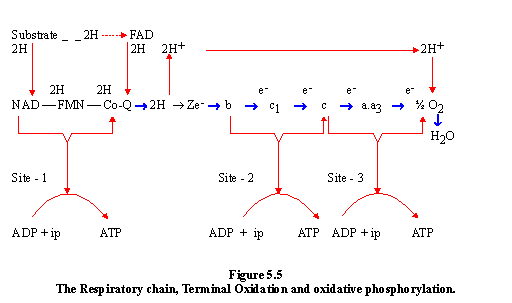This is the final part of the phase-II of aerobic
respiration. As stated earlier, in respiration, oxidation of the
substrate occurs by dehydrogenation (i.e., removal) of hydrogen
atoms (2H) from the substrate. These are mostly accepted by NAD
to form reduced co-enzyme NADH. In the aerobic respiration of a
molecule of glucose (6-C), a total of, 10 NADH2 are formed,
(2NADH2 in glycolysis + 8 NADH2 in Krebís
cycle).
At one step in Krebís cycle, hydrogen is accepted
by FAD to form FADH2. total, 2#FADH2 are formed
in the aerobic respiration of each glucose.
Each molecule of reduced co-enzyme thus formed
in aerobic respiration (glycolysis and Krebís cycle) is finally
oxidized by the free molecular oxygen through a process called terminal
oxidation.

This involves participation of the respiratory
chain, also called electron transport system
(ETS).

Click Here To Enlarge
The respiratory chain (or the ETS) is present in
the inner membrane of mitochondrion (i.e., in the cristae membrane).
It consists of various enzymes and co-enzymes which act as electron
carriers.
The hydrogen ions (and the electrons of hydrogen)
from the oxidized substrate pass through the ETS and finally react
with free molecular oxygen to form water.